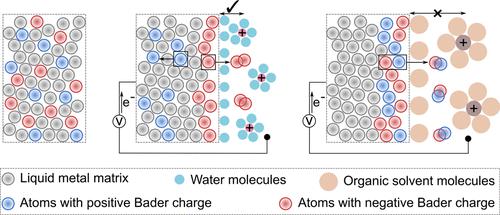当前位置:
X-MOL 学术
›
Chem. Mater.
›
论文详情
Our official English website, www.x-mol.net, welcomes your feedback! (Note: you will need to create a separate account there.)
Interface-Controlled Phase Separation of Liquid Metal-Based Eutectic Ternary Alloys
Chemistry of Materials ( IF 8.6 ) Pub Date : 2022-11-30 , DOI: 10.1021/acs.chemmater.2c02981 Mahroo Baharfar 1 , Jiewei Zheng 1 , Roozbeh Abbasi 1 , Sean Lim 2 , Varun Kundi 1 , Priyank V. Kumar 1 , Md. Arifur Rahim 1 , Chengchen Zhang 1 , Kourosh Kalantar-Zadeh 1, 3 , Mohannad Mayyas 1
Chemistry of Materials ( IF 8.6 ) Pub Date : 2022-11-30 , DOI: 10.1021/acs.chemmater.2c02981 Mahroo Baharfar 1 , Jiewei Zheng 1 , Roozbeh Abbasi 1 , Sean Lim 2 , Varun Kundi 1 , Priyank V. Kumar 1 , Md. Arifur Rahim 1 , Chengchen Zhang 1 , Kourosh Kalantar-Zadeh 1, 3 , Mohannad Mayyas 1
Affiliation

|
Liquid metals (LMs) are immiscible in many common electrolytic solutions and, when immersed in them, establish phase boundaries that display intriguing interfacial characteristics. The application of a cathodic potential to such interfaces may trigger phase separation of solute elements out of the LMs. Here, we investigate this possibility in two of the most researched and industrially used eutectic ternary LMs of Galinstan (Ga-In-Sn) and Field’s metal (FM, In–Bi–Sn). We observe that upon surface perturbation by an applied electric potential, solute elements compete to segregate out of the LM alloys according to their energy levels. The nature of the electrolytic solutions plays a key role in the separation process as they dictate whether solute metals are expelled selectively in their pure form or as binary compounds. For example, in a phosphate-based aqueous electrolyte, nano-sized Sn-based entities are selectively expelled from Galinstan, while only Bi-based structures leave the surface of FM. In contrast, in a non-aqueous electrolyte, nano-sized binary compounds of Sn–In and Bi–Sn are separated from the surfaces of Galinstan and FM, respectively. We show that selectivity in the surface separation process, achieved by the alteration of the electrolytic solutions, is due to the interplay between the electrodynamic interactions and the electrocapillary effect. This study presents two key findings: (a) it is essential to carefully consider the possibility of component separation in electrochemical systems based on LMs and (b) it demonstrates interfacial metallurgical pathways to process alloys for refining metals into specific purities, component ratios, and dimensions.
中文翻译:

液态金属基共晶三元合金的界面控制相分离
液态金属 (LM) 在许多常见的电解溶液中不混溶,当浸入其中时,会建立显示有趣界面特征的相界。将阴极电势应用于此类界面可能会触发溶质元素从 LM 中相分离。在这里,我们在 Galinstan (Ga-In-Sn) 和 Field 金属(FM,In-Bi-Sn)这两种研究最多和工业使用的共晶三元 LM 中研究了这种可能性。我们观察到,在施加电势的表面扰动下,溶质元素根据其能级竞争从 LM 合金中分离出来。电解液的性质在分离过程中起着关键作用,因为它们决定了溶质金属是以纯形式还是二元化合物形式选择性地排出。例如,在基于磷酸盐的水性电解质中,纳米尺寸的 Sn 基实体被选择性地从 Galinstan 中排出,而只有 Bi 基结构离开 FM 的表面。相反,在非水电解质中,Sn-In 和 Bi-Sn 的纳米级二元化合物分别从 Galinstan 和 FM 的表面分离。我们表明,通过改变电解溶液实现的表面分离过程的选择性是由于电动力学相互作用和电毛细管效应之间的相互作用。本研究提出了两个主要发现:(a) 必须仔细考虑基于 LM 的电化学系统中成分分离的可能性,以及 (b) 它展示了界面冶金途径,以将合金加工成特定纯度、成分比例的合金,以及方面。
更新日期:2022-11-30
中文翻译:

液态金属基共晶三元合金的界面控制相分离
液态金属 (LM) 在许多常见的电解溶液中不混溶,当浸入其中时,会建立显示有趣界面特征的相界。将阴极电势应用于此类界面可能会触发溶质元素从 LM 中相分离。在这里,我们在 Galinstan (Ga-In-Sn) 和 Field 金属(FM,In-Bi-Sn)这两种研究最多和工业使用的共晶三元 LM 中研究了这种可能性。我们观察到,在施加电势的表面扰动下,溶质元素根据其能级竞争从 LM 合金中分离出来。电解液的性质在分离过程中起着关键作用,因为它们决定了溶质金属是以纯形式还是二元化合物形式选择性地排出。例如,在基于磷酸盐的水性电解质中,纳米尺寸的 Sn 基实体被选择性地从 Galinstan 中排出,而只有 Bi 基结构离开 FM 的表面。相反,在非水电解质中,Sn-In 和 Bi-Sn 的纳米级二元化合物分别从 Galinstan 和 FM 的表面分离。我们表明,通过改变电解溶液实现的表面分离过程的选择性是由于电动力学相互作用和电毛细管效应之间的相互作用。本研究提出了两个主要发现:(a) 必须仔细考虑基于 LM 的电化学系统中成分分离的可能性,以及 (b) 它展示了界面冶金途径,以将合金加工成特定纯度、成分比例的合金,以及方面。



























 京公网安备 11010802027423号
京公网安备 11010802027423号